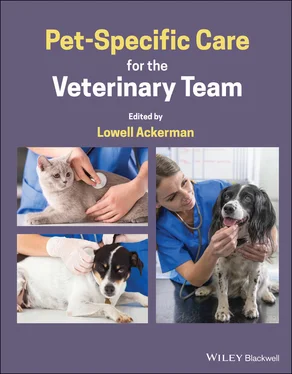Pet‐specific care is also client centric since decisions are ultimately made by caregiving pet owners. While it is important that veterinary teams focus on standards of care (see 9.4Standards of Care), care pathways (see 9.6Care Pathways), and regarding intervention on a continuum of care (see 9.7Continuum of Care and Convergence Schedules), it takes more than that to deliver pet‐specific care. To deliver pet‐specific care effectively, veterinary teams need to also provide a specified level of care, which in turn is dependent on consistency of care (see 9.8Ensuring Consistency of Care) within the practice. In addition to standards of care and level of care, veterinary teams also need to be aware that not all clients can afford recommended services, so a spectrum of care may be needed. Affordability of veterinary services is a real concern for some pet owners (see 2.10Affordability of Veterinary Services), but options are still available (see 10.14Providing Cost‐Effective Care for Those in Need; 2.2 The Role of Incremental Care; 7.8 Providing Care for Those Unable or Unwilling to Pay; and 6.5 Opportunities and Challenges of Providing Services for Low‐Income Families).
1.1.3.1 Why Pet‐Specific Care Rather than Pet‐Specific Medicine?
While the goal of pet‐specific care is better health outcomes, and there are many medical aspects to healthspan, it is also true that some of the most important aspects of success with pet‐specific care involve owner engagement in health management rather than disease management. Pet owners need to play an active role in keeping their pets healthy, not just bringing those pets in for veterinary care when something goes wrong.
The nomenclature is not yet fixed, but pet‐specific care suggests that there are many important aspects to care that are not necessarily medical in nature. A commitment by pet owners to feed a nutritious and balanced diet, to promote appropriate behaviors, to ensure their pet remains within a normal body condition score, and to provide regular at‐home oral care are all very important health factors. So is ensuring pets have regular exercise, socialization, and access to enrichment in their environments. Some may even say that promoting behavioral health is one of the best ways of ensuring medical health, since behavioral issues are more likely to result in relinquishment than medical problems (see 6.9Preventing Behavior Problems).
Pet owners need to consider home issues such as fencing and shelter, pet‐proofing their home to avoid mishaps, making plans for someone to care for their pets when they are away, as well as making financial decisions for how to care for their pet in sickness and in health. They also need to do more than just go to the veterinarian and buy recommended products. Compliance and adherence are critical factors, and owners need to be prepared to follow veterinary recommendations at home, when they are not under direct medical supervision (see 9.17Improving Compliance and Adherence with Pet‐Specific Care). For all these reasons and many more, the term pet‐specific care is preferred (at least currently) over the variety of other synonyms that are being used.
Veterinary healthcare teams definitely facilitate pet‐specific care, but owners must be engaged in the process and willingly accept their healthcare guardian role and take the responsibility seriously.
While all pet owners should aspire to pet‐specific care, it is reasonable to predict that not all will embrace the topic initially, as well as be prepared to pay for it. Early adopters are likely to be owners of new pets, and the market segment known as pet parents. These are the early adopters, but when success is achieved with these individuals, it is possible to leverage that success across the entire hospital population. However, even a small contingent of proponents can have a powerful impact on pets and the teams that care for them. According to Pareto's principle, if 20% of clients embrace pet‐specific care, they can contribute to 80% of positive outcomes (see 10.2The Importance of Practice Differentiation).
Pet‐specific care is all about managing risks, so the very first step typically involves assessing pets for risks based on their individual circumstances (see 1.2Providing a Lifetime of Care). In most cases, this first happens during puppy and kitten visits, often at around 8 weeks of age.
All animals have certain risks that pertain to their individual circumstances. By acknowledging and prioritizing risks, we can craft meaningful personalized action plans for our patients (see 1.3Personalized Care Plans). In addition, once we have identified risks, pet owners can decide how they might best manage the financial aspects of those risks, including pet health insurance (see 10.16Pet Health Insurance).
For most pets, family history, genotype, and breed predisposition are significant contributors to disease susceptibility (see 11.4Heritable Health Conditions – by Breed). This is true whether the pet is purebred, hybrid, or mixed‐breed. In many instances, when a pet is mixed‐breed and the parents have not been identified with certainty, it may be difficult to discern any type of predisposition without performing breed composition genetic testing. Whether purebred, hybrid or mixed‐breed, both genotypic and phenotypic testing are important to detect disease susceptibility (see 3.11Integrating Genotypic and Phenotypic Testing).
Exposure risks constitute another significant contributor to disease susceptibility. For example, a pet exposed to many other pets will be at increased risk for infectious diseases and, potentially, parasite transmission. A pet that is taken for walks in wooded areas may be exposed to ticks that are enzootic to the region and may introduce tick‐related infections to the pet.
Susceptibility to medical problems is also influenced by life stages and preexisting conditions. For example, an umbilical hernia is more likely to be congenital and evident in a juvenile pet, while most cases of hypothyroidism present during adulthood. Regarding preexisting conditions, a pet with early evidence of hip dysplasia will be more likely to develop osteoarthritis later in life.
A pet's gender as well as its neuter status also influence risk (see 4.2Gender‐Related Considerations). Some diseases are sex‐limited in nature (such as prostatic disease in males or pyometra in females), but there are also sex predispositions for a variety of disorders. For example, there may be a modest sex predisposition in females regarding cutaneous lupus erythematosus, while adrenal sex hormone imbalance (also known as alopecia X) may be more commonly diagnosed in males. This is different from disorders that are transmitted genetically on the sex chromosomes. For example, hemophilia is more often clinically evident in males because the condition is transmitted on the X chromosome as a sex‐linked recessive condition, and since males only have one X chromosome (they are said to be hemizygous; the other is a Y chromosome), they are more likely to manifest the condition. Neuter status also affects risk. Bitches spayed before their first estrus have a reduced prevalence of mammary cancers; neutered males have a lowered risk for prostatic hyperplasia. New guidelines even suggest the most appropriate age for neutering on a pet‐specific basis.
Geography also plays a significant role in disease susceptibility, partially because it influences infectious diseases that are present in the area or the vectors that are associated with their transmission. Accordingly, when creating health plans, it is important to take into consideration whether or not the pet may travel outside its residential region.
Even conformation and nondisease traits can be associated with predisposition to disease. For example, cats with white fur may be at higher risk for developing squamous cell carcinoma; color dilution alopecia is more common in dogs with diluted coloring patterns, such as “blue” Dobermans, etc.
Читать дальше












